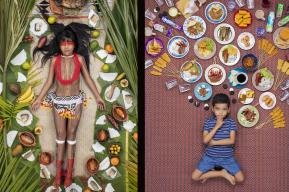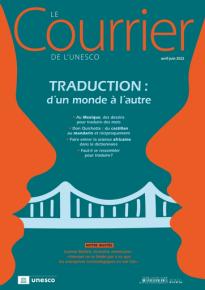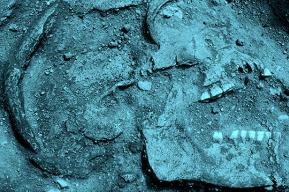فكرة
يانيك لاهينز: "هايتي تُسائل الحداثة مُشيرة إلى تناقضاتها وحدودها"

يانيك لاهينز، شخصية لها مكانتها في المشهد الأدبي الهايتي، تتحدّث في هذا الحوار عن أعمالها المستلهمة من الثقافة الشعبية والحية لبلدها، بعيدًا عن الكليشيهات الغارقة في البؤس. سرديّاتها المتفرّدة وحسّها الشعري يحملان صدَى تاريخ الجمهورية السوداء الأولى، التي هي في الآن ذاته "نتاج الحداثة وردّ فعل على هذه الحداثة".
أجرت المقابلة أنياس باردون
اليونسكو
كيف توصّلتم إلى اختيار الكتابة كطريقة خاصّة جدّا لتسكنوا بها هذا العالم؟
أعتقد أن "الكلمات تختارنا لأننا في وحدة" كما يقول الشاعر الهايتي جورج كاستيرا. فالكلمات تُصبح وسيلة للتواصل مع الجانب الخفيّ فينا، ومع معارفنا الحميمية، ومع أولئك الذين، يسلكون، من خلال قراءة ما نكتب، الطرق المُؤدية إلى عوالمهم الخفية ومعارفهم الحميمية. فأن تكتب يعني أن تتحمّل، في الآن ذاته، وحدتك وتحاول الخروج منها، رغم ما في الأمر من مفارقة.
وأن تكون كاتبًا يعني أنك تشعر بالحاجة إلى إضفاء معنى على الواقع، وأن تصوغه ضمن منظور معيّن أملا في أن تملأ بالكلمات شيئا ما أساسيا ينقصنا، تماما كما يفعل آخرون عن طريق الموسيقى أو الرّسم والألوان.
هلاّ حدّثتينا عن المكان الذي تكتُبين فيه؟
الأماكن التي أكتب فيها في المنزل عديدة (غالبًا ما تكون لديّ قُصاصات ورقيّة صغيرة في جيبي)، لكن مكاني المفضّل هو غرفتي. فوق مكتبي توجد قطعة أتبرّك بها وهي حصاة مصقولة رُسمت عليها سمكة وأعشاب بحرية على خلفية طينيّة اللّون. أعتقد أنها تُلخص جيّدا كلّ ما هو حيّ من معادن وحيوان ونبات. وقد حوّلَتْها اليدُ البشرية إلى قطعةً فنية.
بورت أو برنس هي الشخصية المركزية في كتابك "الهزائم العذبة" Douces déroutes. كما أن المدينة تتنزّل أيضًا في قلب مؤلّفكِ "الشروخ" أو "الشقوق" Failles، الذي كُتب في أعقاب الزلزال الذي ضرب العاصمة الهايتية في يناير 2010. كيف تلهم المدينة والبلد أعمالك؟
أنا فتاة من هذه المدينة. في مجموعتي القصصية الأولى، "العمّة ريزيا والآلهة" Tante Résia et les dieux، يُوجد نصّ يحمل عنوان "المدينة"، وهو عبارة عن نزهة طويلة لشخصية تحاول المسك بامرأة ترتدي فستانًا أحمر. هذه النزهة ليست في الحقيقة سوى ذريعة لاستحضار تاريخ هذه المدينة وأساطيرها وحاضرها القوي والمُحيّر والحي. ومن ثمّة، أعود إلى ذاتي لأُسائل التاريخ، والأساطير، والجغرافيا، وقوة الحياة، والعالم في الصّورة التي هو عليها بما تحمله من مظاهر عدم المساواة، والمآسي والجمال، رغم كل الصّعاب.
ما هو الدّور الذي لعبته النساء في الأدب الهايتي؟
أعتقد أن دورهن أصبح أكثر وضوحا منذ أواخر الثمانينات، ويعود الفضل في ذلك إلى عمل الجماعات النسوية التي سلّطت الأضواء على الدّور السياسي والتاريخي للنّساء في هايتي. ذلك ما سمح لنا بالعودة إلى الإنتاج الأدبي وخاصة أعمال الروائية والكاتبة المسرحية ماري شوفي التي أدخلت الرواية الحديثة، بصفة فعلية، إلى هايتي بفضل ثلاثيتها "حب وغضب وجنون" Amour, Colère et Folie. مذ وقتها، ظهر جيلان جديدان من الكاتبات. والجدير بالذكر أنهن يكتبن أيضًا باللّغة الكريُولية.
كنتِ أول من حمل لقب كرسي العوالم الفرنكوفونية في الكوليج دي فرانس بباريس، وعنونتِ الدّرس الذي تولّيتِ تقديمه سنة 2019 "إلحاح (إلحاحات) الكتابة، الحلم (الأحلام) بالعيش" Urgence(s) d’écrire, rêve(s) d’habiter عن أي طوارئ تتحدثين؟
لقد وُلدنا في هايتي في حالة طوارئ لم تُفارقنا أبدًا. فالثورة الهايتية، وهي الثورة الثالثة في العصر الحديث بعد ثورة الولايات المتحدة وفرنسا، دفعت بعيدا بمشروع الأنوار بحكم راديكاليتها ولكونها مناهضة للاستعمار والعنصرية والعبودية. فنحن معيار العلاقات التي أنشأتها هذه الحداثة بين الشمال والجنوب والمرجع الأمّ لها.
ولئن حاولت نُخبنا إعادة إنتاج نموذج المدينة الميتروبولية السابقة، فإنّ ثقافة شعبية مناهضة للاسترقاق قد تطوّرت بالتوازي مع ديانة الفودو؛ ومع لغة الكريول، كما تطوّرت أيضًا طريقة معينة لاحتلال الفضاء، وكذلك العلاقات الزوجية، إلخ. كان الكتّاب الأوائل، المنحدرون من النّخبة، يكتبون بالفرنسية تعبيرا منهم عن وجودهم كسودٍ وكبشر. وظهر أدب شفوي باللغة الكرييُولية على امتداد أكثر من قرن نشأت عنه اليوم كتابة. ونحن نستند اليوم إلى هاتين الرّكيزتين.
واليوم، ما زلنا في حالة طوارئ بما أن العلاقات بين الشمال والجنوب لم تتغيّر بشكل أساسي، على حدّ علمي. ومن ناحية أخرى، فإن تواطؤ النخب للحفاظ على هذه العلاقات ما زال جليًّا في دول الجنوب. هذا وقد استطاع الكتّاب والفنّانون عموما أن يبدعوا على خلفية يسودها الشعور بالضيق والغضب وبعزيمة على الكتابة وهم في "في حالة شعرية"، أو كما يقول الشّاعر والكاتب الهايتي ريني ديبيستر: "ازدهرت حالة الشّعر على بُعْدِ سنواتٍ ضوئية من حالات الطوارئ والاستنفار".
في مقالِكِ "المنفى: بين الترسّخ والهروب" L’Exil : entre l’ancrage et la fuite، تُبيّنين أنّ الأدب الهاييتي تشقّه حركة متضاربة بين التّوق إلى الخارج وإرادة البقاء. كيف يُترجم هذا التأرجح؟
هذا التأرجح كان دائما موجودا. في البداية، أذكّر بأنّنا مجتثّون (أو مقتلعون من منشئنا). ثمّ إنّ الكثيرين عملوا على جعل هذه الأرض غير صالحة للسكن، وأخيرًا، فإنّ فكرة أن الأفضل لا يمكن أن يوجد سوى في غير هذا المكان (المقصود به الشمال) مازالت ماثلة في مُخيّلة المستعمَرين السابقين. فتضافر هذه العوامل الثلاثة خلق هذا التّأرجح أو التّذبذب بين الترسّخ والهروب.
كيف تواصل الثورة الهايتية، التي جعلت من هذا البلد أول جمهورية سوداء حرة، مُساءلة الحداثة؟
نحن، في الآن ذاته، نتاج الحداثة وردّ فعل على هذه الحداثة. فنحن حضارة حديثة العهد، وُلدت من الاختلاط والالتقاء بين المحيط الأطلسي وبحر الكاراييب. نحن نُسائل الحداثة لأننا نشير إلى تناقضاتها وحدودها. وجودنا يمثّل، منذ البداية، وسيلة لاقتراح إعادة النّظر في كونية الأنوار.
ماذا يقول الأدب الهايتي اليوم؟
الهجرة هي أحد المصائر الرئيسية لبلدان الجنوب التي أصبحت أراضيها غير صالحة للسّكن. لذلك، هاجر الهايتيون كثيرًا منذ بداية القرن العشرين، حاملين معهم تلك الثقافة التي نشأت في القرن التاسع عشر والتي يُعتبر الأدب تعبيراً عنها مثله مثل سائر الأشكال الفنية الأخرى. هناك آداب هايتية متعدّدة اليوم، منها التي تصدر في هايتي باللغة الكريولية وبالفرنسية، والتي تُكتب بالإنجليزية في الولايات المتحدة، وما هو بصدد الكتابة بالإسبانية في أمريكا اللاتينية وحتى في جمهورية الدومينيك، وما يكتب بالفرنسية في فرنسا وكندا. هذه الأدبيات هي صورة استباقية عن ذلك العالم الناشئ المتعدّد، وعن التعدّدية اللغوية التي يشير إليها إدوارد جليسان في مؤلّفه "الخطاب الأنتيلي" Le Discours antillais.
يانيك لاهينز
يانيك لاهينز، مؤلفة مقالات وقصص قصيرة وروايات، نذكر منها "لون الفجر" La Couleur de l'aube، و"حمّام ضوء القمر" Bain de lune ، و"الهزائم العذبة" Douces déroutes. درّست قبل ذلك الأدب في جامعة ولاية بورت أو برنس. حصلت على العديد من الجوائز وتُرجمت أعمالها بالخصوص إلى الإنجليزية، والبرتغالية، واليابانية، والألمانية، والإيطالية. وهي مقيمة في بورت أو برنس.
مطالعات ذات صلة
هايتي: الهبّة، رسالة اليونسكو، سبتمبر 2010
مقابلة مع ريني ديبيستر: بين الطوباوية والواقع، رسالة اليونسكو، ديسمبر 1997
تكريما لإدوارد جليسان: التفكير في الجميع، رسالة اليونسكو، أبريل - يونيو 2011
اشترك في رسالة اليونسكو لمتابعة الأحداث. الاشتراك في النسخة الرقمية مجاني %100.
Interview by Agnès Bardon
UNESCO
How does one decide to choose this very particular way of living that is the world of writing?
Like the Haitian poet Georges Castera, I believe that “words choose us because we are alone”. Words become a way of communicating with our own mystery, our intimate knowledge, and of communicating with those who, by reading us, explore their own mystery and the intimate knowledge that is theirs. Writing involves accepting solitude, and, at the same time paradoxically, trying to escape it.
To be a writer is to feel the need to make sense of reality, to put it into perspective in order to fill a fundamental void with words, as others might do through music, or through drawing and colours.
To be a writer is to feel the need to make sense of reality
Could you describe the place where you write?
There are many places in the house that I write in – I often carry pieces of paper in my pockets – but my favourite place is my bedroom. On my desk, I have a fetish object, a pebble on which a fish and seaweed are drawn on an ochre background. I think it sums up life well – mineral, fauna and flora all at once. It’s the human hand that has made it an objet d’art.
Port-au-Prince is the central character in your book Douces déroutes [Gentle diversions]. It is also at the heart of Failles [Faults], which was written in the aftermath of the earthquake that struck the Haitian capital in January 2010. How do the city and the country inform your work?
I am a daughter of this city. In my very first collection of short stories, Tante Résia et les dieux [Aunt Résia and the Spirits and Other Stories], there is a story called “La Ville” [The City], which describes the long journey of a character trying to catch a woman wearing a red dress. This wandering is a pretext for evoking the history of this city – its myths, its powerful, disconcerting, and lively present. From there, I reflect on myself – I question history, myths, geography, the life force, the world as it is, with its inequalities, its misfortunes and its beauty, against all odds.
What role have women played in the literature of Haiti?
I think their role has become much more obvious since the late 1980s. This is thanks to the work of feminist groups that have highlighted the historical and political role of women in Haiti. This has enabled us to revisit our literary heritage – especially the work of the novelist and playwright Marie Chauvet, who truly introduced the modern novel to Haiti with her trilogy Amour, Colère et Folie [Love, Anger, Madness: A Haitian Triptych]. Since then, two generations of female writers have emerged. It is interesting to note that they also write in Creole.
As the first person to hold the Francophone Worlds Chair at the Collège de France in Paris, you called the course you gave there in 2019 “Urgence(s) d'écrire, rêve(s) d'habiter” [Urgency to write, dream(s) of living]. What is the urgency that you referred to?
We were born in Haiti during an emergency that has never left us. The Haitian revolution [1791-1804], the third revolution in modern times after the United States and France, pushed the Enlightenment project further with its radicalism. It is anti-colonial, anti-racist and anti-slavery. We are the mould and the matrix of the North-South relations established by this modernity.
If our elites tried to reproduce the model of the old metropolis, an anti-plantation culture developed in parallel – with a religion, voodoo; a language, Creole; but also a way of occupying space, matrimonial relations, etc. The first writers who came from the elite, wrote in French to say that we exist as Blacks and as human beings. For over a century, an oral literature has been developed in Creole, and is now appearing in the written word. We are leaning on these two pillars of support.
Today, we are still in this state of emergency because, as far as I am aware, North-South relations have not fundamentally changed. Also, the complicity of the elites in maintaining these relations is still just as obvious for countries in the South. Writers, and artists in general, have created against a backdrop of distress and anger, but with the will to write “in a state of poetry”. As the Haitian poet René Depestre says: “The state of poetry is flourishing, light years away from the states of siege and alarm”.
For over a century, an oral literature has been developed in Creole, and is now appearing in the written word
In your essay, L’Exil: entre l’ancrage et la fuite [Exile: between anchorage and flight], you show that Haitian literature is marked by a paradoxical movement between a longing to be elsewhere and a desire to stay. How does this oscillation manifest itself?
It has always existed. First, we are all transplanted people. Next, many people have worked hard to make this country uninhabitable. And finally, in the imagination of the ex-colonized, there is this idea – that must always be resisted – that the best can only be found elsewhere, in the North. The combination of these three factors has created this oscillation between anchoring and flight.
The Haitian revolution made the country the world’s first Black Republic. How does it continue to question modernity?
We are both a product of this modernity, and a response to it. We are a recent civilization born from the mixing and meeting of the Atlantic and the Caribbean seas. We question modernity because we see its contradictions and limitations. From the very beginning, our existence has been a way of rethinking the universality of the Enlightenment.
What does Haitian literature have to say today?
Migration is one of the major destinies of countries in the South, whose lands have been rendered uninhabitable. Many Haitians have therefore migrated since the beginning of the twentieth century – taking with them this culture, which was formed in the nineteenth century, and of which literature is one form of artistic expression among others.
Today, there are [several] Haitian literatures. One that is created in Haiti, in Creole and French. One that is being written in English, in the United States. One that is being written in Spanish, in Latin America and even in the Dominican Republic. And one that is being created in French, in France and Canada.
These literatures are a prefiguration of the multiple world that is emerging, and of the multilingualism that Édouard Glissant evokes in Le Discours antillais [Caribbean discourse].
Yanick Lahens
A major figure in Haitian literature today, Yanick Lahens was born in Port-au-Prince, where she returned after attending school and university in France. Author of essays, short stories and novels, she has won many awards, including the prestigious Prix Fémina in 2014, for Bain de lune (Moonbath). Lahens’ work has been translated into English, Portuguese, Japanese and Italian. She previously taught literature at the university in Port-au-Prince, and worked for France’s Ministry of Culture. She is also involved in numerous projects dedicated to the fight against illiteracy in her country, and a project addressing the issue of slavery through art and literature.

More from Our Guests








